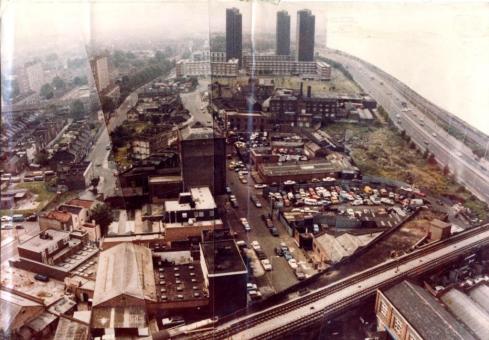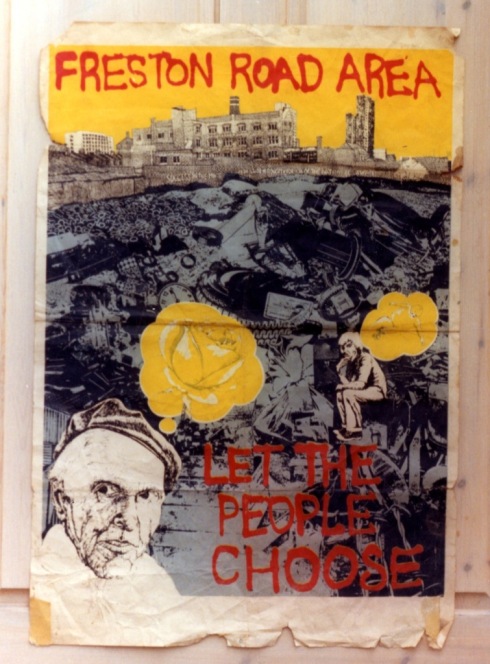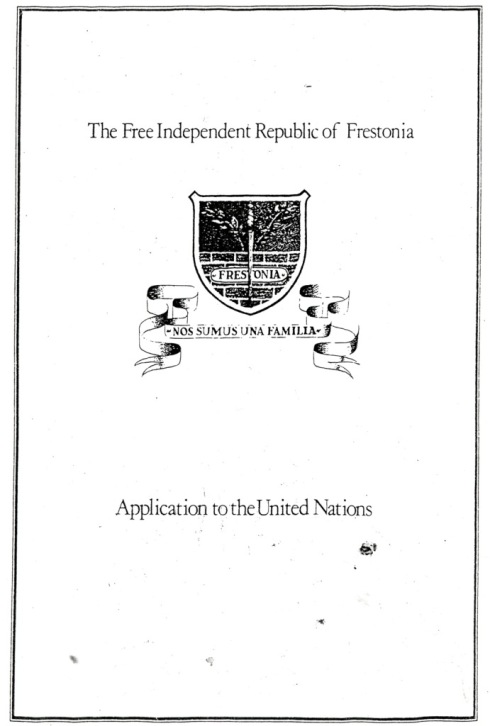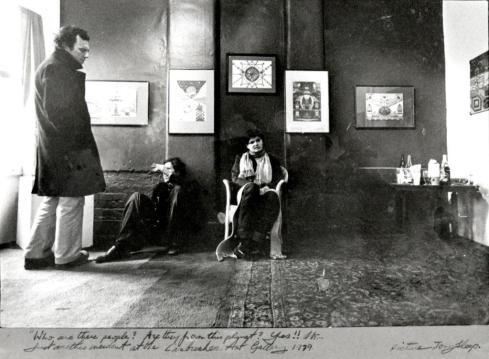Once upon a time in a galaxy far, far away (the past) a brave person of restricted growth and his staunch companions threw off the bonds of oppression and created their own magical land…….
Well, perhaps that’s not the way to tell it. North Kensington, once called by Michael Moorcock “the most delicious slum in Europe” was once a hotbed of community activism. Barricades were built, protests were made, community newspapers were published, councillors were locked in meeting halls. In the days before social media and citizen journalism, people made theselves heard with all the means at their disposal. One of those means was the creation of the Free Republic of Frestonia.
The building of the Westway cut through North Kensington leaving some parts of it a bit stranded. Latimer Road was truncated, Walmer Road was bisected (see this post, which has many interesting comments from former residents) and the area south of Latimer Road was full of empty houses and industrial sites earmarked for development.
[View looking south]
This vacuum was filled in the 70s by squatters who gradually built their own community in the empty houses and vacant sites.
[photo by Tony Sleep]
In 1977 the GLC (the Greater London Council, now just a memory but then an economic and social entity which was itself the size of a small country) decided to clear the area for industrial use.
But the inhabitants were prepared to fight back, at first in the usual way.
[photograph of poster taken by Sue Snyder]
But these were ambitious, even visionary squatters who decided to create a new form of protest by declaring a small part of the area an independent republic in a move reminiscent of the film Passport to Pimlico.
The members of this collective all became ministers of the government.
And as you can see by this list they all added the suffix Bramley (after Bramley Road) to their names, apparently so they would appear to be one large family who in theory would have to be re-housed together.
When you’re sitting a few miles south of the scene of these events and more than thirty years later, looking at scraps of ephemera, cuttings and photographs trying to piece them together it’s hard to see what’s serious and what’s ironic. But from what I’ve read and heard although it took the form of a prank Frestonia itself was both real and serious.
There was an adventure playground:
And an art gallery:
[Photo by Tony Sleep]
A People’s Hall:
[The People’s Hall sometime in the 1970s, judging from the graffitti]
The hall hosted a National Film Theatre of Frestonia (Passport to Pimlico was one of the first films shown).
And more mundane activities.
[A second hand sale. Photo by Tony Sleep (?)]
As you can see from the application to the UN the Foreign Minsister of Frestonia was the charismatic actor David Rappaport, probably most famous for his role in the Terry Gilliam film Time Bandits and his appearances in the last series of Tiswas, although I remember seeing him at the National Theatre in Ken Campbell’s production of the Illuminatus Trilogy. He had something of a gift for generating media interest.
[article from Kensington News and Post 04 November 1977. And yes, I wondered about that spelling error]
The publicity generated by the declaration of independence served its purpose. The then (penultimate) leader of the GLC, Sir Horace Cutler was in direct touch with the government of Frestonia. (Cutler was a flamboyant character but his fame has been eclipsed by that of his successor.) There was a public enquiry which ultimately supported the creation of a mixed use area providing living and working space. Nicholas Albery (Minister of State for the Environment in the government of Frestonia) in his account of his country in Inside Notting Hill (2001 edition) says: “Frestonia was eventually rebuilt…. with foreign aid from Great Britain channelled via the Notting Hill Housing Trust”
Some demolition took place:
[The Carbreaker’s Gallery and the Notting Dale Law Centre awaiting demolition. Is that Henry Dickens Court in the background?]
Many years later the area looked like this, still an area where people live and work. There have been more developments since this picture, taken sometime in the 1990s I think.
(Note all the instances of graffitt visible from this angle, one of which is above a Paint Shop. I should also just draw your attention to the housing block with the rounded shape on the left of the picture, known as the Ark by some of its inhabitants.)
Postscript
As I hinted above this is a sketch of Frestonia loosely pieced together from what I could lay my hands on, rather than any kind of definitive account. I had to employ a certain amount of guesswork about dating. If there’s anything you’d like to add please use the comments section. I’d certainly like to hear more about Frestonia and its residents.
Most of the pictures this week come from the HistoryTalk collection. I’ve identified the photographer if the information was available. The photographer Tony Sleep has a website with many more images at: http://tonysleep.co.uk/frestonia
For further reading take a look at Inside Notting Hill and Melvyn Wilkinson’s Book of Notting Hill.
David Rappaport died in Los Angeles in 1990.
Postscript to the Postscript
Notting Hill Housing (funded by Norland Ward Councillors for City Living Local Life Initiative) are having some History Walk and Talk sessions on Frestonia on 29th April and 6th May at 5.15pm (both days). Photographs taken on the day will be exhibited in a further session on May 27th. Contact Resa on 07931 523607 for further details.
















April 24th, 2015 at 7:30 am
Thanks Dave. That’s a great over view of Frestonia. I’m surprised no one has made this into a film (sequel to Passport to Pimlico). You might be interested to know that the Frestonian’s eventually formed themselves into the Bramley Housing Co-Op and helped to design the housing that now sits at the corner of Bramley and St Annes Road. I believe some of the original community still live here or their children. Also there is a new public sculpture in the area. Anyone passing Latimer Road station will see a large surreal abstract sculpture of an apple tree on the roof of the new housing development, More West. This was designed by Turner nominated artist, Nathan Coley. This is partly about the Bramley (apple) community of squatters. In a recent interview, Nathan said: “There’s a lovely story that one of their group found out, that if they were the same family, the council would need to rehouse them all. So what they did was to rename themselves with the same surname. It’s recorded that over 120 of them changed their second name to Bramley. Bramley being one of the roads in the area. The idea that the council would have to rehouse 120 of them is rather beautiful, It’s a small political act that is humorous at the same time. I guess that I was fascinated by the fact that ultimately Frestonia failed. They didn’t create this utopian notion of how to live. I like the idea of the art work being on the roof and you can never touch it because it’s an echo of this ideal or idealised world.”
August 27th, 2015 at 9:56 pm
Every time I tell people about Frestonia they’re surprised there isn’t a film about it. That’s partly why I wrote a screenplay dramatising the events around the late ’70s (I’m still trying to get it made).
I’m working on a ‘National Archive’ at http://www.frestonia.org and there’s a great presentation of Nathan Coley’s work on his site here:
http://www.studionathancoley.com/works/to-the-bramley-family-of-frestonia-book/images/9
Thanks for including the newspaper article in the post. I hadn’t seen that before.
April 28th, 2015 at 4:56 pm
A fascinating piece of history and post. Photographer Tony Sleep is interviewed about living in Frestonia in a 2011 Radio 4 documentary ‘From Frestonia to Belgravia: The History of Squatting’. You can listen to it in the Radio 4 website archive. Summary from the R4 website:
Against a backdrop of high unemployment and a reported million empty properties former squatter Robert Elms charts the history of squatting. He assesses the ideology and mythology that has surrounded this subversive search for a home. As the Government consider new legislation to further criminalise squatting, could it soon be a thing of the past?
http://www.bbc.co.uk/programmes/b017cfv4
May 7th, 2015 at 8:48 am
Lillian
Thanks for this. Very useful.
Dave
May 7th, 2015 at 6:43 pm
I’d meant to add that, while the whole documentary is interesting and worth listening to, if anyone just wants to hear the Frestonia segment, it starts at the 15-minute mark.
May 3rd, 2015 at 9:34 am
Yes the past is another country and we did things differently there. I lived in Freston Road from 1976 – 1987, throughout my 20’s & early 30’s.
Stretching along Bramley Road and both sides of Freston Road, the squatters settled and became a housing co-operative made up of 3 distinct groups, the central bit where I lived was informed by radical feminist activism. This women’s community seems to have become invisible in historical accounts though images of us are often used.
My own primary memory is of horrible brown rice risottos, endless talking, sitting naked in the summer sunshine in the ramshackle communal garden, or wearing layers of woolly jumpers nattering in each others’ shabby unheated sitting rooms in the winter. The air was usually blue with smoke from spliffs, roll-ups and incense.
We sat on the trodden muddy grass or gritty worn rugs, arguing, listening, shouting, discussing power, gender, race, childcare, madness, sex, monogamy, poverty and how to challenge white male entitlement.
The many small children ran and swirled in a grubby gang up and down the garden, casually sure of a welcome at houses whose doors were unlocked and open throughout the seasons.
“Frestonia” was a brief game, not the pinnacle or the point of those decades. Its purpose was partly to play, partly to make a stance to try to push back the inevitable tearing down of our homes.
Squatting was ending; the supply of post-war semi derelict empty houses had dried up. A bunch of punks and hippies had no weight in contrast to the societal 1980’s move from creating homes for people, to building financial assets.
When the street was pulled down and replaced with modern houses and a large block of flats, I watched my beautiful Victorian cottage draped in wisteria being demolished.
I got a one-bed flat with a tiny single bedroom, on a second floor in the block.There was no space for my toddler & baby to have cots each to sleep in, let alone play.
The under-occupying part time dads who’d somehow been allocated roomy family houses, refused to swap with the overcrowded families who’d ended up in tiny flats. Hippiedom was dead and I felt my young world dissolving.
We stuck it there for 3 months then moved away. In those days key workers with a local connection could drop into a housing association and ask to register with a realistic chance of getting housed. I was quickly offered a home to rent in Ladbroke Grove and bade farewell to the co-op.
I avoid going past Freston Road although I live barely ten minutes walk away. It makes me too sentimental, too cross and far too sad.
But the hope and intelligence of the feminist and anarchic debates we lived out for those retrospectively sunlit years, has coloured the rest of my adult life.
I think we are collectively returning to those questions now, but I have no idea how the power shifts can be levered this time, to really make change.
May 7th, 2015 at 8:43 am
Lizzie
Thanks for this. As I said in the post the accounts we have of Frestonia in our collection don’t amount to much more than a sketch so I’m pleased to get your contribution.
Dave
August 27th, 2015 at 10:43 pm
[…] Article originally published in the Kensington News and Post on November 4th, 1977 and republished at rbkclocalstudies.wordpress.com […]
January 4th, 2016 at 9:55 pm
Reblogged this on theperfumedgardens and commented:
nicked _
February 19th, 2016 at 11:07 am
Actually it’s ‘The past is a foreign country’ – ‘another’ is a strangely ubiquitous mis-quote.
February 19th, 2016 at 4:34 pm
Dixie
I became aware of my mistake weeks after the post was published so I thought I’d leave it. Do you think the mis-quote is gradually replacing the original?
Dave
August 5th, 2017 at 8:21 am
[…] Walker, D. (2015) ‘Frestonia: the past is another country’ The Royal Borough of Kensington and Chelsea Library. https://rbkclocalstudies.wordpress.com/2015/04/23/frestonia-the-past-is-another-country/ […]
September 9th, 2017 at 2:33 pm
A surprising amount of us still exist, now Bramleys Housing Co operative Ltd. Three generations! Not the famous names ofcourse, some faded away, some had the opportunity to upsize their living requirements, and sadly the 3 early ‘founders’ Nicholas Albery, David Rappaport and Heathcliff Williams, have all died. Yes society has changed and so have we. But we celebrate with a local party each year in the communal garden, and preserve our housing list.